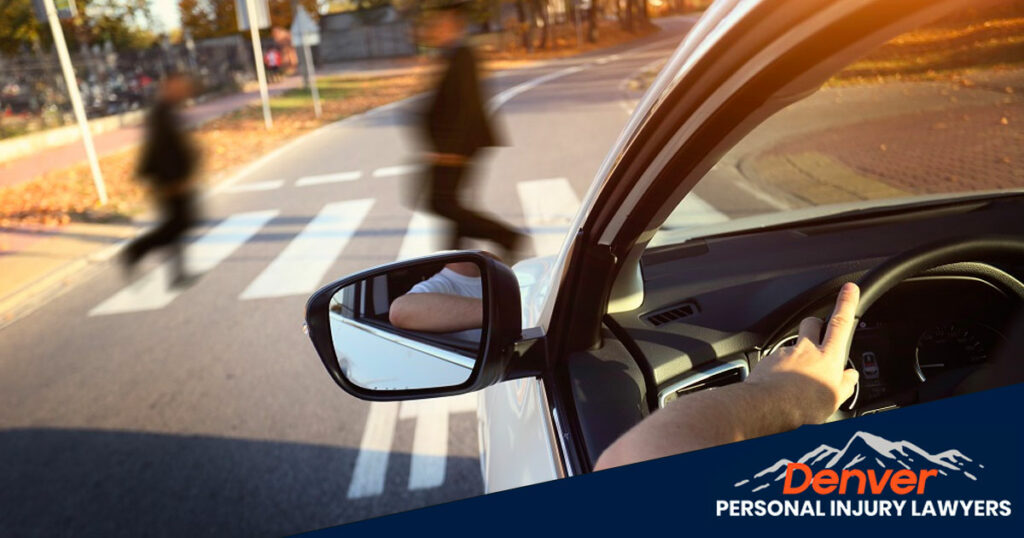If you were injured in a Denver pedestrian accident, you need to prove that the driver was negligent in order to claim damage compensation. Sometimes this is difficult when there are no witnesses or the driver does not tell the truth.
We often take for granted that we can cross a street without getting injured. But not everyone is so fortunate; in fact, there are about 5,000 pedestrian fatalities and 70,000 pedestrian injuries, according to the Colorado Department of Transportation, with small children and older adults being the highest risk groups.
Table of Contents
ToggleDenver Pedestrian Accident Statistics in 2023
CDOT’s latest data reveals 37 pedestrians have already died this year in traffic crashes. To help combat pedestrian deaths and injuries, the Colorado Department of Transportation has launched its “Left Behind Campaign”. It’s meant to help raise awareness of pedestrians and encourage drivers to pay more attention while driving.
Are You Injured From a Denver Pedestrian Accident?
If you sustained injuries in a Denver pedestrian accident, you may need to hire an experienced Denver pedestrian accident lawyer.
An attorney can play a monumental role in helping you recover for all damages you’re entitled to, including medical expenses and lost income. They also know how to conduct a thorough investigation and get all the necessary evidence to prove the at-fault driver’s negligence.
Determining Liability in a Denver Pedestrian Accident
Determining liability in a Denver pedestrian accident can be a complex process. The initial phase occurs right after the accident; it’s when law enforcement report to the scene and issue a citation to the alleged at-fault party and make an official incident report. However, a citation does not mean the case is closed or that liability is set in stone.
It’s possible the at-fault party will contest liability or completely shift the blame onto the pedestrian. When there is any uncertainty surrounding liability, the insurance claims process will take longer and the case may even end up going to court.
What Factors Will a Judge or Jury Consider to Determine Liability?
If your case ends up going to court, a jury will consider various factors to determine liability. While each accident case is unique and thus needs to be evaluated on an individual basis, one thing is true across all cases: the determination of fault is very fact-specific. So, if a driver was violating the law while they hit a pedestrian, it will be easier to prove fault. For instance, let’s say a drunk driver hit a pedestrian. In that case, it will be pretty obvious that the driver was at fault and establishing liability may be straightforward. However, that’s not always the case.
Another factor a judge or jury will look at is whether or not the pedestrian was crossing at a crosswalk. If they were, that means they legally had the right of way and are less likely to be found comparatively negligent (or partially at fault). However, if a pedestrian was crossing a street where they didn’t legally have the right of way, they might be found partially liable for the accident. But if the pedestrian was
When Can the At-Fault Party Make an Argument Regarding Liability?
Any involved parties can make an argument regarding liability. In fact, it’s pretty common for the at fault party to argue liability, even when it’s clear that they were at fault. This is because of the way the legal system works – it gives everyone a chance to defend their stance and argue their case.
Is Liability in a Pedestrian Accident Different From a Car Accident Case?
The basis for establishing liability in all personal injury cases – whether for auto or pedestrian accidents – is a negligence standard.
However, pedestrian accident cases are not exactly the same as car accident cases when it comes to determining liability. That’s because pedestrians are not operating a motor vehicle and therefore do not have the same duty of care that drivers have.
Can a Pedestrian Be Partially Negligent in an Accident?
There are some situations when a pedestrian can be partially at fault for their injuries. For instance, if a pedestrian suddenly runs out into the middle of oncoming traffic on the highway. In this scenario, a driver who hits a pedestrian might not be fully liable. That’s because a driver can’t reasonably anticipate a pedestrian crossing a highway since pedestrians don’t legally have the right-of-way there.
What if the Driver Was Distracted or Speeding When They Caused a Pedestrian Collision?
If a driver is distracted, drunk, speeding, or somehow negligent and causes an accident, they won’t have a strong basis for claiming comparative negligence. All drivers in Denver who operate motor vehicles have a “duty of care” to drive in a reasonably safe manner.
Likewise, if a driver was speeding while they hit a pedestrian, this could be considered negligence. They will likely be found partially or completely liable since they shouldn’t have been speeding in the first place. To illustrate, let’s consider an example. A pedestrian who was crossing the street could assert that they made a reasonable judgment call and believed they had enough time to cross the street. However, if they miscalculated the amount of time they had to safely cross the street because the car was speeding 20 mph over the posted speed limit, they will likely have the benefit of the doubt. In this scenario, the speeding driver is driving at a reckless speed and has clearly impacted the pedestrian’s ability to accurately assess the car’s distance. Hence, the speeding driver is likely to be found partially or mostly liable.
What Damages Can I Recover in a Denver Pedestrian Accident?
After getting injured in a Denver pedestrian accident, you may be eligible to claim damages by way of settlement or a jury verdict on a personal injury claim. The following are various types of compensatory damages you may be entitled to based on your accident circumstances:
Economic Damages (C.R.S. § 13-21-111.6)
Economic damages usually have documentation you can use to easily calculate the exact value. Examples of economic damages include medical bills, lost wages, and car repair costs, and any future loss of income. An attorney can help you track economic damages, accurately calculate them, and show how they are directly linked to your accident injuries. Under Denver law, all of your medical bills are considered an economic damage.
Non-Economic Damage (C.R.S. § 13-21-102.5)
Non-economic damages and losses entail those which don’t have fixed cost. They are more subjective and require legal expertise to interpret and determine a fair value. Examples of non-economic damages include pain and suffering, loss of enjoyment in life, loss of consortium, mental anguish, and more.
Physical Impairment (C.R.S. § 13-21-102.5(5)
Physical impairment damages include any full or partial loss of any use of a body part. In Denver, there is no cap for physical impairment damages (unlike non-economic damages, which are capped).
How Long Do I Have to File a Pedestrian Injury Claim in Denver?
Personal injury claims in Denver related to auto accidents allow three years for the injury victim to file a claim. The clock starts ticking on the date of the ancient, so contact an attorney as soon as possible to ensure you protect your right to financial recovery.
Call a Denver Pedestrian Accident Lawyer For Legal Help
If you were injured by a careless or reckless driver in a Dener pedestrian accident, you need a skilled Denver personal injury lawyer to fight for you. Gearing up with strong legal counsel will help protect your rights and maximize your potential financial reimbursement. A skilled attorney knows how to help you gather crucial evidence to support your claim. Evidence is the foundation for a successful Denver personal injury claim.
Call us today for a free initial consultation.
















